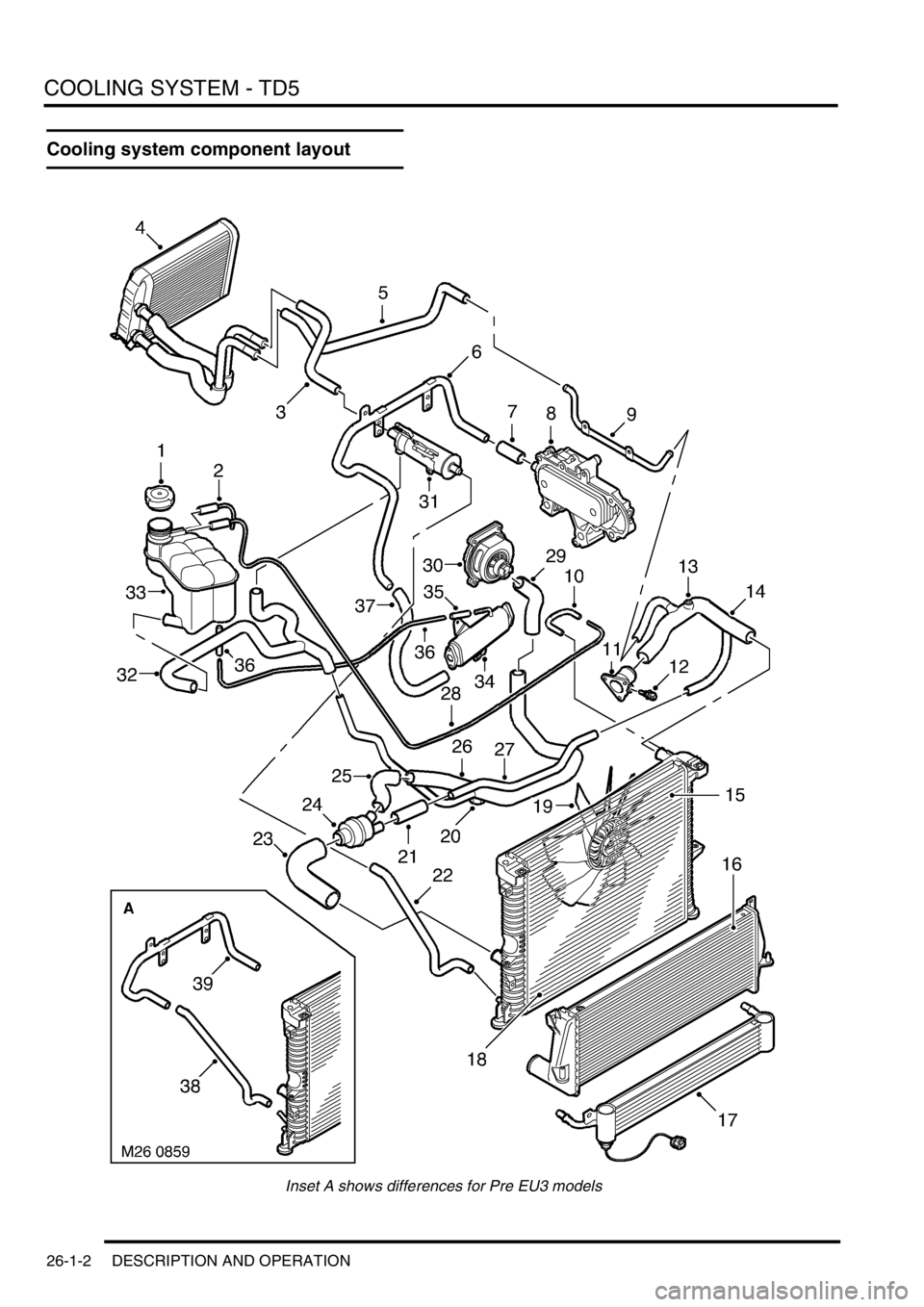2002 LAND ROVER DISCOVERY cooling system
[x] Cancel search: cooling systemPage 532 of 1672

ENGINE MANAGEMENT SYSTEM - V8
REPAIRS 18-2-75
4.Fit CKP sensor heat shield and secure with
bolts.
5.Fit underbelly panel and secure with fixings.
6.Remove stand(s) and lower vehicle.
7.Connect battery earth lead.
8.Fit battery cover and secure the fixings.
9.Reset adaptions using TestBook.
Sensor - radiator temperature
$% 18.30.20
Remove
1.Disconnect battery earth lead.
2.Position container to collect coolant spillage.
3.Disconnect multiplug from sensor.
4.Remove sensor and discard sealing washer.
Refit
1.Fit new sealing washer to sensor.
2.Fit and tighten sensor.
3.Connect multiplug to sensor.
4.Refill cooling system.
5.Connect battery earth lead.
Page 538 of 1672

ENGINE MANAGEMENT SYSTEM - V8
REPAIRS 18-2-81
5.Connect multiplug to throttle body.
6.Connect throttle and cruise control cables.
l
+ ENGINE MANAGEMENT SYSTEM
- V8, ADJUSTMENTS, Cable - cruise
control.
l
+ ENGINE MANAGEMENT SYSTEM
- V8, ADJUSTMENTS, Cable - throttle.
7.Position air intake hose and secure clips.
8.Top-up cooling system.
Plenum chamber
$% 19.22.46
Remove
1.Remove upper manifold gasket.
+ MANIFOLDS AND EXHAUST
SYSTEMS - V8, REPAIRS, Gasket - inlet
manifold - upper - Without Secondary Air
Injection.
2.Remove 2 bolts securing throttle cable
abutment bracket and remove bracket.
3.Remove breather hose adaptor.
4.Remove 4 bolts securing plenum chamber to
upper manifold and remove plenum chamber.
5.Collect plenum chamber gaskets.
Refit
1.Clean plenum chamber and upper manifold
mating faces.
2.Using new gaskets, position plenum chamber
fit bolts and tighten to 22 Nm (16 lbf.ft).
3.Fit breather adaptor and tighten to 6 Nm (4.4
lbf.ft).
4.Position throttle cable abutment bracket, fit
bolts and tighten to 9 Nm (7 lbf.ft).
5.Fit upper manifold gasket.
+ MANIFOLDS AND EXHAUST
SYSTEMS - V8, REPAIRS, Gasket - inlet
manifold - upper - Without Secondary Air
Injection.
Page 584 of 1672

COOLING SYSTEM - TD5
DESCRIPTION AND OPERATION 26-1-1
Deze pagina werd opzettelijk niet gebruikt
Cette page est intentionnellement vierge
Questa pagina è stata lasciata in bianco di proposito Diese Seite ist leer
Esta página foi deixada intencionalmente em branco
Esta página fue dejada en blanco intencionalmente This page is intentionally left blank
COOLING SYSTEM - Td5 DESCRIPTION AND OPERAT ION
Page 585 of 1672

COOLING SYSTEM - TD5
26-1-2 DESCRIPTION AND OPERATION
Cooling system component layout
Inset A shows differences for Pre EU3 models
Page 586 of 1672

COOLING SYSTEM - TD5
DESCRIPTION AND OPERATION 26-1-3
1Pressure cap
2Overflow pipe
3Heater return hose
4Heater matrix
5Heater inlet hose
6Oil cooler return pipe — EU3 models
7Connecting hose
8Oil cooler housing assembly
9Heater inlet pipe
10Connecting hose
11Outlet housing
12Engine Coolant Temperature (ECT) sensor
13Bleed screw
14Radiator top hose
15Radiator - upper
16Intercooler
17Gearbox oil cooler
18Radiator - lower
19Viscous fan
20Drain plug21Connecting hose
22Fuel cooler feed hose
23Radiator bottom hose
24Thermostat housing
25Connecting hose
26Coolant pump feed pipe
27Coolant by-pass pipe
28Radiator bleed pipe
29Connecting hose
30Coolant pump
31Fuel cooler
32Heater/expansion tank return hose
33Expansion tank
34EGR Cooler - EU3 models
35Connecting hose - EU3 models
36Connecting hose - EU3 models
37Hose - EGR Cooler to oil cooler return pipe -
EU3 models
38Radiator lower feed hose - Pre EU3 models
39Oil cooler return pipe - Pre EU3 models
Page 587 of 1672

COOLING SYSTEM - TD5
26-1-4 DESCRIPTION AND OPERATION
Cooling system coolant flow
Coolant flow diagram
aEU 3 Models
bPre EU3 Models
Page 588 of 1672

COOLING SYSTEM - TD5
DESCRIPTION AND OPERATION 26-1-5
Description
General
The cooling system used on the Diesel engine is a pressure relief by-pass type system which allows coolant to
circulate around the engine block and heater circuit when the thermostat is closed. With coolant not passing through
the by-pass or the radiator promotes faster heater warm-up which in turn improves passenger comfort.
A coolant pump is mounted on a casting behind the PAS pump and is driven from the PAS pump at crankshaft speed
by the auxiliary drive belt. The pump mounting casting connects with passages in the cylinder block and pumps
coolant from the radiator through the cylinder block.
A viscous fan is attached to an idler pulley at the front of the engine. The fan is attached to a threaded spigot on the
pulley with a left hand threaded nut. The fan draws air through the radiator to assist in cooling when the vehicle is
stationary. The fan rotational speed is controlled relative to the running temperature of the engine by a thermostatic
valve regulated by a bi-metallic coil.
The cooling system uses a 50/50 mix of anti-freeze and water.
A Fuel Burning Heater (FBH) is available as an optional item for Diesel engine variants. The FBH is located on the
bulkhead and is connected in series in the coolant supply to the heater. The FBH is used to compensate for the
relatively low coolant temperatures inherent in the Diesel engine.
+ HEATING AND VENTILATION, DESCRIPTION AND OPERATION, Description.
Thermostat housing
A plastic thermostat housing is located behind the radiator. The housing has three connections which locate the
radiator bottom hose, top hose and coolant pump feed pipe. The housing contains a wax element thermostat and a
spring loaded by-pass flow valve.
Thermostat - Main valve
The thermostat is used to maintain the coolant at the optimum temperature for efficient combustion and to aid engine
warm-up. The thermostat is closed at temperatures below approximately 82
°C (179°F). When the coolant
temperature reaches approximately 82
°C the thermostat starts to open and is fully open at approximately 96°C
(204
°F). In this condition the full flow of coolant is directed through the radiator.
The thermostat is exposed to 90% hot coolant from the engine on one side and 10% cold coolant returning from the
radiator bottom hose on the other side.
Hot coolant from the engine passes from the by-pass pipe through four sensing holes in the flow valve into a tube
surrounding 90% of the thermostat sensitive area. Cold coolant returning from the radiator, cooled by the ambient air,
conducts through 10% of the thermostat sensitive area.
In cold ambient temperatures, the engine temperature is raised approximately 10
°C (50°F) to compensate for the heat
loss of 10% exposure to the cold coolant returning from the radiator bottom hose.
By-pass flow valve
The by-pass flow valve is held closed by a light spring. It operates to further aid heater warm-up. When the main valve
is closed and the engine speed is below 1500 rev/min, the coolant pump does not produce sufficient flow and pressure
to open the valve. In this condition the valve prevents coolant circulating through the by-pass circuit and forces the
coolant through the heater matrix only. This provides a higher flow of warm coolant through the heater matrix to
improve passenger comfort in cold conditions.
When the engine speed increases above 1500 rev/min the coolant pump produces a greater flow and pressure than
the heater circuit can take. The pressure acts on the flow valve and overcomes the valve spring pressure, opening
the valve and limiting the pressure in the heater circuit. The valve modulates to provide maximum coolant flow through
the heater matrix and yet allowing excess coolant to flow into the by-pass circuit to provide the engines cooling needs
at higher engine rev/min.
Page 589 of 1672

COOLING SYSTEM - TD5
26-1-6 DESCRIPTION AND OPERATION
Outlet housing
A cast aluminium outlet housing is attached to the cylinder head with three bolts and sealed with a gasket. Coolant
leaves the engine through the outlet housing and is directed through a hose to the heater matrix, the radiator or the
by-pass circuit.
An Engine Coolant Temperature (ECT) sensor is installed in a threaded port on the side of the outlet housing. The
sensor monitors coolant temperature emerging from the engine and sends signals to the Engine Control Module
(ECM) for engine management and temperature gauge operation.
+ ENGINE MANAGEMENT SYSTEM - Td5, DESCRIPTION AND OPERATION, Description.
Expansion tank
The expansion tank is located in the engine compartment. The tank is made from moulded plastic and attached to
brackets on the right hand inner wing. A maximum coolant when cold level is moulded onto the tank.
Excess coolant created by heat expansion is returned to the expansion tank from the radiator bleed pipe at the top of
the radiator. An outlet pipe is connected into the coolant pump feed hose and replaces the coolant displaced by heat
expansion into the system when the engine is cool.
The expansion tank is fitted with a sealed pressure cap. The cap contains a pressure relief valve which opens to allow
excessive pressure and coolant to vent through the overflow pipe. The relief valve is open at a pressure of 1.4 bar (20
lbf.in
2) and above.
Heater matrix
The heater matrix is fitted in the heater assembly inside the passenger compartment. Two pipes pass through the
bulkhead into the engine compartment and provide coolant flow to and from the matrix. The pipes from the bulkhead
are connected to the matrix, sealed with 'O' rings and clamped with circular rings.
The matrix is constructed from aluminium with two end tanks interconnected with tubes. Aluminium fins are located
between the tubes and conduct heat from the hot coolant flowing through the tubes. Air from the heater assembly is
warmed as it passes through the matrix fins. The warm air is then distributed in to the passenger compartment as
required.
+ HEATING AND VENTILATION, DESCRIPTION AND OPERATION, Description.
When the engine is running, coolant from the engine is constantly circulated through the heater matrix.
Radiator
The 44 row radiator is located at the front of the vehicle in the engine compartment. The cross flow type radiator is
manufactured from aluminium with moulded plastic end tanks interconnected with tubes. The bottom four rows are
separate from the upper radiator and form the lower radiator for the fuel cooler. Aluminium fins are located between
the tubes and conduct heat from the hot coolant flowing through the tubes, reducing the coolant temperature as it
flows through the radiator. Air intake from the front of the vehicle when moving carries the heat away from the fins.
When the vehicle is stationary, the viscous fan draws air through the radiator fins to prevent the engine from
overheating.
Two connections at the top of the radiator provide for the attachment of the top hose from the outlet housing and bleed
pipe to the expansion tank. Three connections at the bottom of the radiator allow for the attachment of the bottom
hose to the thermostat housing and the return hose from the oil cooler and the feed hose to the fuel cooler.
The bottom four rows of the lower radiator are dedicated to the fuel cooler. The upper of the two connections at the
bottom of the radiator receives coolant from the oil cooler. This is fed through the four rows of the lower radiator in a
dual pass and emerges at the lower connection. The dual pass lowers the coolant temperature by up to 24
°C before
being passed to the fuel cooler.
Two smaller radiators are located in front of the cooling radiator. The upper radiator is the intercooler for the air intake
system and the lower radiator provides cooling of the gearbox oil.
+ EMISSION CONTROL - Td5, DESCRIPTION AND OPERATION, Emission Control Systems.
+ MANUAL GEARBOX - R380, DESCRIPTION AND OPERATION, Description.
+ AUTOMATIC GEARBOX - ZF4HP22 - 24, DESCRIPTION AND OPERATION, Description.